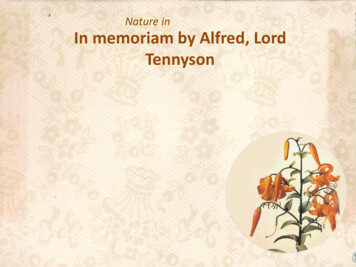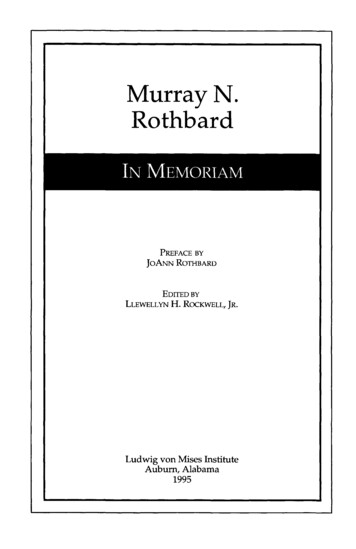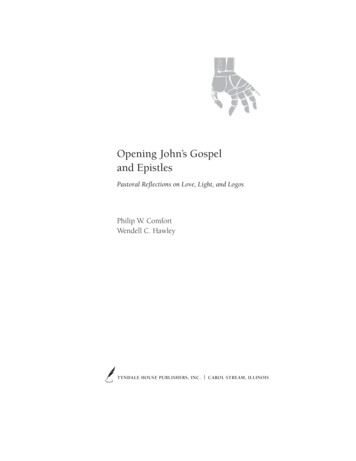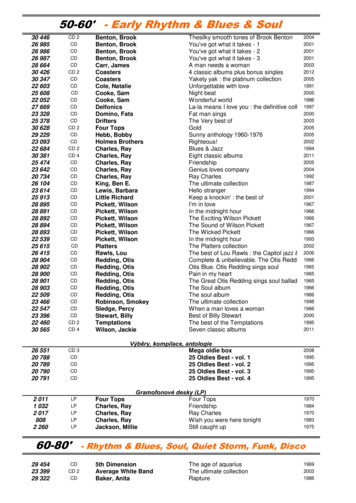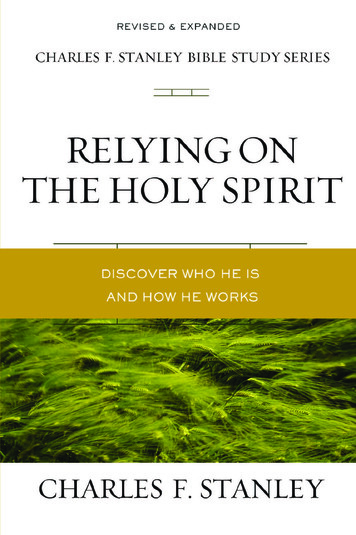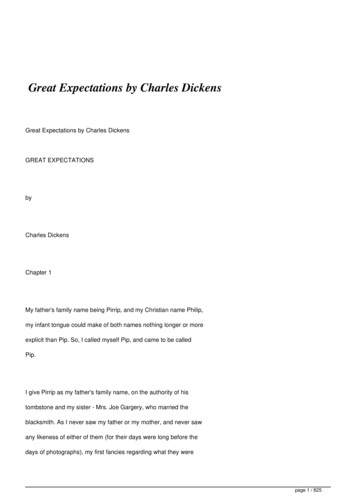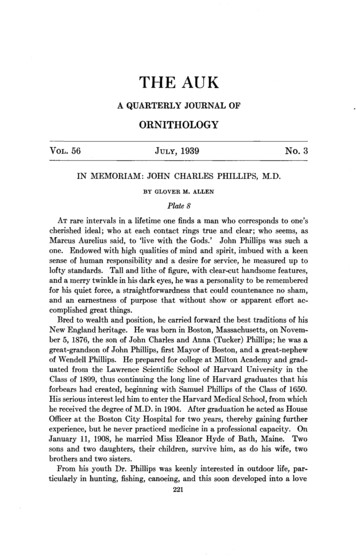
Transcription
THEAUKA QUARTERLYJOURNAL OFORNITHOLOGYVo . 56IN MEMORIAM:Ju .Y, 1939JOHN CHARLES PHILLIPS,BYGLOVERM.No. 3M.D.ALLENPlate 8AT rare intervalsin a lifetime one findsa man who correspondsto one'scherishedideal; who at each contact rings true and clear; who seems,asMarcus Aureliussaid, to 'live with the Gods.' John Phillipswas suchaone. Endowedwith high qualitiesof mind and spirit,imbuedwith a keensenseof human responsibilityand a desirefor service,he measuredup tolofty standards. Tall and lithe of figure,with clear-cuthandsomefeatures,anda merrytwinklein hisdark eyes,hewasa personalityto be rememberedfor his quietforce,a straightforwardnessthat couldcountenanceno sham,and an earnestnessof purposethat without showor apparenteffort accomplishedgreat things.Bred to wealthand position,he carriedforwardthe besttraditionsof hisNew Englandheritage. He wasbornin Boston,Massachusetts,on November 5, 1870,the sonof JohnCharlesand Anna (Tucker)Phillips;he wasagreat-grandsonof JohnPhillips,first Mayor of Boston,and a great-nephewof WendellPhillips. He preparedfor collegeat Milton Academyand graduated from the Lawrence ScientificSchoolof Harvard University in theClassof 1899,thus continuingthe long line of Harvard graduatesthat hisforbearshad created,beginningwith SamuelPhillipsof the Classof 1050.His seriousinterestled him to enter the Harvard Medical School,from whichhe receivedthe degreeof M.D. in 1904. After graduationhe actedas HouseOfficerat the BostonCity Hospital for two years, thereby gainingfurtherexperience,but he neverpracticedmedicinein a professionalcapacity. OnJanuary 11, 1908, he marriedMiss EleanorHyde of Bath, Maine. Twosonsand two daughters,their children,survive him, as do his wife, twobrothers and two sisters.From his youth Dr. Phillips was keenly interestedin outdoorlife, particularlyin hunting,fishing,canoeing,and this soondevelopedinto a love221
Tns AvI , Von. 56Pna cs8
222ALLEN,In Memoriam:JohnCharlesPhillips[Auk[Julyof intelligenttravel which often led him in later years to far horizons.Alwayshis journeyshad in view a first-handacquaintancewith naturalconditionsin distant regions,and the pursuit or observationof wildlife.He appearsto havekept a journalof importanteventsfrom boyhood,andin 1915,he publishedhis 'Boy Journals,1887-1892'in a very smalleditionfor private distribution. This valuable habit no doubt made easier thefrequentpreparationof brief accountsof his observationsand reflections.In variousshorterjourneyshe visitedmanypartsof the westernUnitedStates and Canada, and in 1900 publisheda short accountof his firstbighorn-sheephunt in Wyoming. The region of the present GlacierNational Park attracted him long before it was thoughtof as a publicreservation,and severalof its prominentgeographicfeaturesnow bear thenameshe gavethem. In 1896,whilestill in the midstof his collegecareer,he accompaniedPeary as far as Greenland,on one of the North Polarexpeditions.Ten yearslater, we find him with his friend TheodoreLyman,visitingJapanand Korea,with a digressioninto SouthChinato hunt tiger.More seriousexpeditionshe undertookin 1912-13 to the Blue Nile valleyand the bordersof Abyssinia(now Ethiopia), and in 1914 to Sinai andPalestine, bringing back important collectionsof birds and mammalswhichhe presentedto the Museumof ComparativeZo61ogy.Other travelstook him to out of the way cornersof North America: Newfoundland,Alaska,Lower California;he spentpart of a winter in hunting mountainlions and peccariesin the mountainsof Arizona, and in 1938 with Dr.ThomasBarbour,visitedCuba and Florida. His last extensiveexpeditionwasin 1923-24,when with his wife and son, John, he traveled throughKenya Colony,to Ugandaand the easternBelgianCongo,partly with a viewto seeingthe African gamefields,with their contrastsof plain and forest.He was the first secretaryof the Harvard Travellers Club, organizedin1902.It wasmy owngoodfortuneto haveaccompaniedDr. PhillipsonhisBlueNile journey, now well over a quarter of a centuryago. The memoriesofthat trip, in spite of its many difficulties,still remain an abidingdelight,quite as muchfor the joy of associationwith one of his geniusas for theaddedknowledgeof this part of the earth. For Dr. Phillipstook a keeninterestin the thingshe saw,whetherhisfellowmen,the wild game,or thegloriouscountry. As a campmate his even temper and bright senseofhumor helpedto carry over temporarydiscomforts.I well recall ourfirst day out with camels--it was Christmas--andhis amusementat theannouncementofourabsurdlittle 'dragoman'George:'Sir,it isverywonderful what hashappenedto our lunch.' It seemedthat stray dogshad madeway with it during the previousevening. Thereafter, the task of provisioningwasnot left wholly to George. AlthoughDr. Phillipsenjoyedthe
Vol. 56]1939JAr.r.rN,In Memoriam:JohnCharlesPhillipsß223thrill of goodhunting,he caredlittle about the shootingof animalsfortrophies,but preferredthat the gamehe seenredshouldbe properlypreservedfor museumstudy.Followingtheoutbreakof the GreatWar, Dr. Phillipsfelt that hismedicalknowledgeshouldbe turnedto accountto help his fellowmen, with theresult that in November 1915, he joined the SecondHarvard SurgicalCorpsfor serviceabroad. He wascommissionedan HonoraryLieutenantin the Royal Army MedicalCorpsand assignedto GeneralHospitalNo. 2of the BritishExpeditionaryForce. On the completionof that servicehereturnedhome,but in September1917,with the entranceof this countryinto the struggle,he wasgivena commissionin the United StatesArmyMedicalCorpsasFirstLieutenant. In Decemberof the sameyear,he wasmadea Captain,andin May 1918,asMajor, hewasappointedCommandingOfficerof the 33d Field Hospitalof the Fourth RegularArmy Division.He took part in three importantoffensivesin Franceand afterwardwaswith the Army of Occupationiri Germany. He returnedto the UnitedStatesin July 1919,after twenty-sixmonthsof war service,of whichfourteenwerespentin Franceand Germany.The wideextentof Dr. Phillips'sinterestin naturalhistoryiswellreflectedin his publishedwritings,a list of whichhe preparedand issuedin 1933.A glanceat this list with its 169 titles, to whichhe later added35 more,revealsthe progressof his thoughtfrom mattersconcerninghuntingandfield observationto more seriousstudiesof problemsin speciallyon the ducksand geese,while in later yearsthe difficultiesand needsof conservationbecameincreasinglymattersof concern.Foremostin hisinterestwerethe waterfowl.On the shoresof WenhamLake, borderinghis beautifulestate,he maintaineda parture,the changesand fluctuationsin numbersof the manyducksandgeesethatstoppedthereon passage.Shootingwasa passionwith him, not only ofwaterfowlbut alsoof uplandgame. With a well-traineddog,he delightedto tramp the coversfor woodcockor grouse,enjoyingquiteas muchtheexhilarationof beingin the fieldsand woodsas the thrill of an occasionalsuccessfulshot. Alwayshe wasa 'sportsman'in the bestsense,bellevlnginfair playfor thegame,moderationin he need. Natural resourceshe regardedas a heritageto be enjoyedlegitimately,administeredwisely,and handedon to thecominggenerationswith the leastimpairmentpossible.In this,unfortunatelyhe often foundhisfellowsportsmenfar lessopenminded,a stateofaffairsthat frequentlycalledforth from his pen straight-flungwordsofwarningand protestagainstshort-sightedpolicies.In his bibliography,the first item was a shortaccountin 'Forestand
224ALLEN,In Memoriam:JohnCharlesPhillips 'Auk[JulyStream'for 1900of hisfirsthunt for bighornin Wyoming;thiswasfollowedby other notesin the samejournal on night-huntingfor Black Duck, thegamevalueof the newlyintroducedpheasants,the gameanimalsof GlacierNational Park, and noteson the habitsof moose. In 1910, appearedhisfirst article in 'The Auk,' a paper on the autumnalmigrationof CanadaGeesein Massachusetts,andin succeedingyearstherefollowedotherpaperson the waterfowl migrations. In these years, too, he carried out severalinterestingexperimentswith the collaborationof ProfessorW. E. Castlein transplantinggerminaltissuein guineapigs,and up to the outbreakofthe War, he made a numberof valuablestudieson hybridizationin ducksand pheasants.He maintainedfor a numberof yearsa largecollectionofliving waterfowl,pheasants,and cranesat his Wenhamestate, findingmuch of scientific as well as esthetic interest in the characteristic behaviorand appearanceof thesehandsomebirds. With an ever-increasingappreciationof the needsof conservation,we findhim from 1915onward,preparingfrequentcommunicationson suchsubjectsas the suggestedintroductionofibexinto our Southwest,the oppositionto the new FederalMigratory BirdLaw, propagationof game,the needof sanctuaries,crueltyin sport, thesportsmanand the 'zorphile,'the legitimateuseandencouragementof wildlife resources.His specialinterestin ducksat lengthborefruit in the productionof hisfour splendidquartovolumeson 'The Natural History of theDucks,' 1922-26,in the preparationof whichhis thoroughgoingmethodofwork wasevidencedin the employmentof a skilledlinguistfor severalyearsin the cullingand transcriptionof importantpublishednotesfrom scientificand otherpublicationsin nearlyeveryEuropeanlanguage.The expenseofthis publicationwith its handsomecoloredplateshe largelybore himself.His versatilemind appreciatedalsothe historicalaspectsof naturalhistory,a viewpointthat led him from time to time to publishin bookform a number of valuablerecordsthat otherwisemight havebeenlostto sight,amongthese,excerptsfrom GeorgeWashington'sjournalsconcerningthe sportingactivitiesof that Great American,the fishingadventuresof John Rowe ofBostondrawn from the eighteenth-centurydiariesof that gentleman,the'ShootingJournal of GeorgeH. Mackay, 1865-1922,' and an accountofshootingstandsin easternMassachusetts,to be followedlater by a collection of 'Classicsof the AmericanShootingField' and othersportingsketchesincludinga sumptuoussmallvolume,hisfinal one,on the historyof WenhamLake, that came out shortly after his death. Perhapsone of the mostvaluableof hislater workswasa bibliographyof booksconcerningAmericangamemammalsand birdspublishedbetween1582and 1925,a compilationthat will prove increasinglyusefulas future workersendeavorto reviewthe past history of thesespecies. In 1930, he publishedin collaborationwith F. C. Lincoln,an importantbook on 'AmericanWaterfowl'summing
Vol. 56]1939JA . .rN,In Memoriam:JohnCharlesPhillips225up the presentsituationandspeculatingon the outlookfor the future. Allthis and much more, revealshis intenseconcernin matters pertainingtothe welfareof gameanimalsand, moreespecially,the alarmingdestructionof natural resourcesin moderntimesand the urgentneedfor reforms. Heappreciatedgoodwritingandin hisownworksstroveto cultivateaccurateexpressionwith well-roundedform. In surveyinghis well-chosenlibraryof bookson sportandnaturalhistory,he commentedon the ragged-lookingshelfof Americanbookson huntingand explorationin comparisonwith themoresumptuousworksof many Britishwriters.A completeaccountof Dr. Philllps'spublicservicewouldbe a lengthychronicle. He was ResearchCurator of Birds in the Museum of Compara-tive Zo51ogy,andat varioustimesmadegenerousgiftsof specimensto thatinstitution,includinga splendidcollectionof hornsand antlersof gamemammals,amongthem a numberof recordheads,whichhe had broughttogetherovermanyyears. He wasa memberof theFacultyof thePeabodyMuseumin Cambridgesince1931,and for severalyearswasPresidentofthe Board of Trusteesof the PeabodyMuseumin Salem. His interestinthe BostonSocietyof Natural Historyextendedovera longperiodand hewas in recentyearsone of its Trustees. He was Chairmanof the formerMassachusettsConservationCounciland for six years Presidentof theMassachusettsFish and Game Association. He was a founder and forsevenyears,Chairmanof the AmericanCommitteefor InternationalWildlife Protection;while as 'AmericanObserver,'he attended severalInternational ConservationConferencesabroad, thus devoting in the aggregate,a largeportionof hislatereffortto the cultivationof a widerappreciationof the meaningand requisitesof 'conservation.'In 1019,he waselectedamember of the Boone and Crockett Club, of which he served as Vice-presidentfrom 1028-32,and wasfor a numberof yearsa memberof itseditorialboard. He first becamea memberof the AmericanOrnithologists'Union in 1904 and was elected a Fellow in 1025. He was an honored mem-ber of the Nuttall OrnithologicalClub, thoughhe seldomfoundit possibleto attendits meetings,and at the time of hisdeathwas a directorof theNational Association of Audubon Societies.Withal Dr. Phillipswas an extraordinarilymodestand self-effacingperson.He dislikedall appearanceof notoriety,andcouldonlywithgreatdittleultybe persuadedto givea 'paper'or any accountof his work beforepublicor privategatherings.Yet he wasfearlessin the properexpressionof hisdisapprovalof anyperniciouspracticeandexerteda stronginfluencein securingthe passageof certainneededlegislationby Congress.In his later yearshe spenthis winterswith kis family at SevenOaksPlantation on John'sIsle, South Carolina,wherethe milder seasonsplacedlessof a strain on his system,after a winter of illness. He wrote me of
226ALLr ,In Memoriam:JohnCharlesPhillips[Auk[Julycanoeingup to a sleepingalligatorand of enjoyingthe flowerswhile we inNew Englandwerestill undersnow. On November14, 1938,he wasgrousehuntingin southernNew Hampshirewith a friend,whenhe died suddenlyof heart failurejust as his dogcameto a point and ere the bird flew. Wise,generous,talented,he stroveall his life to give freely of his best,in a highspirit oFservice. For his shiningexamplethe livesof us all are richer.(Acknowledgmentsare due to Dr. Thomas Barbour for his kind permissionto draw for variousfacts uponhis memorialof Dr. Phillips,privately printedin January1939.)
Vol. 1939 56] J A . .rN, In Memoriam: John Charles Phillips 225 up the present situation and speculating on the outlook for the future. All this and much more, reveals his intense concern in matters pertaining to
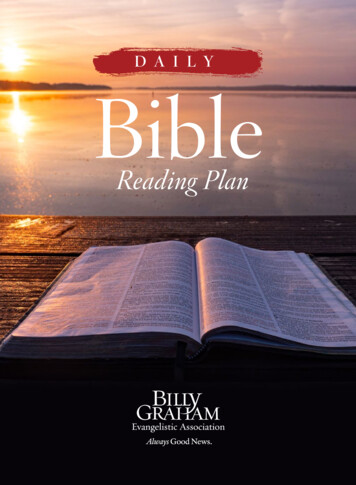

![The Book of the Damned, by Charles Fort, [1919], at sacred .](/img/24/book-of-the-damned.jpg)
